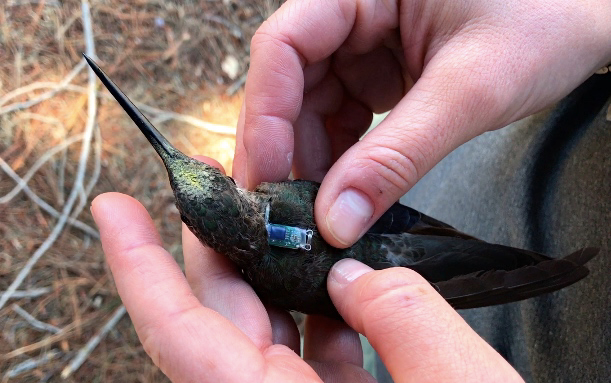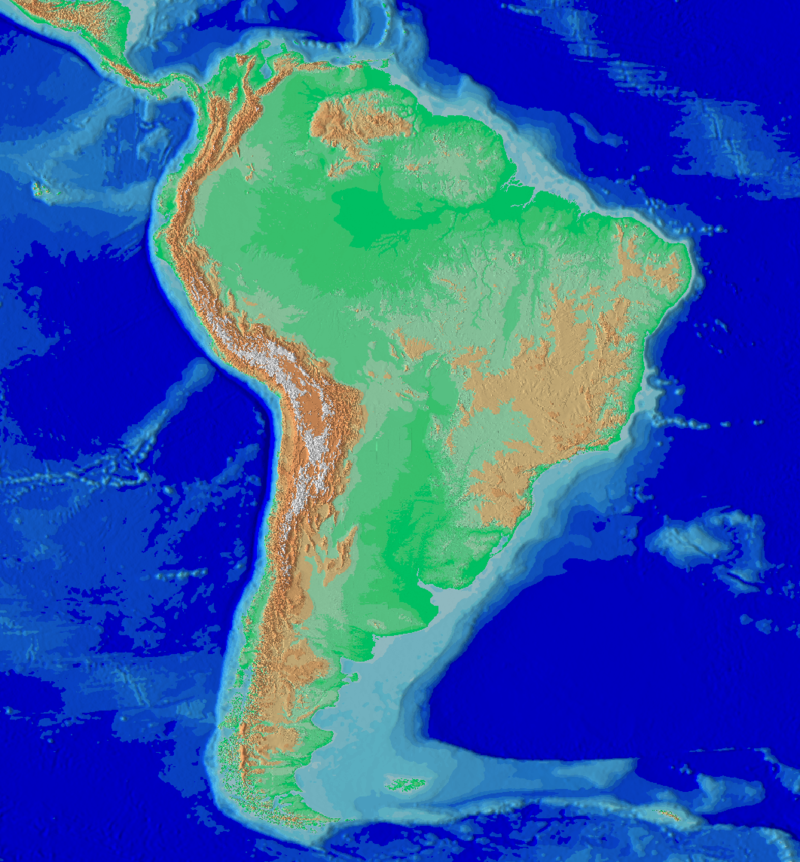Researchers from UNM’s Museum of Southwestern Biology (MSB) in Albuquerque, New Mexico, wanted to know what happens with giant hummingbirds during winter. These birds breed along the Pacific Coast of central Chile, but after that, they just disappear.
Thanks to a tiny backpack adapted for these birds, the team was able to follow them until they were super high in the Andes! And not only that, this study led them to the discovery of a new species of hummingbird that inhabits the Andes. You can read the full study, published on May 13, 2024, at the National Library of Medicine.
Giant hummingbirds, tiny backpacks

The group of researchers found some great assistants for their eight-year-long study. These assistants have feathers, are colorful, move really fast and are tougher than some might think. They are giant hummingbirds!
The team, led by ornithologist Jessie Williamson, wanted to study the migratory habits of giant hummingbirds, as they breed along the Pacific coasts of central Chile and seemingly vanish after breeding. The last clue they had came from Charles Darwin, who in the 19th century speculated they migrated to the Atacama Desert region of northern Chile.
But, how to track them? The team decided to create tiny backpacks that would fit them. Even though giant hummingbirds are the largest kind of hummingbird, they are still only up to 10 inches (25 cm) long. So, their backpacks had to be small and light enough that they wouldn’t interfere with the birds’ hovering style of flight. Williamson wrote:
It took a lot of trial and error to come up with a suitable harness design. Hummingbirds are challenging to work with because they are lightweight with long wings and short legs. They’re nature’s tiny acrobats.
A long flight to the Andes
The team discovered that migratory giant hummingbirds can ascend over 13,000 feet (4 km) in elevation to the high Andes. If you know about the Andes flight disaster that occurred at the Andes in 1972, you know that this environment is extremely rough. This is why hummingbirds employ the same acclimatization strategy used by professional mountaineers. They don’t fly straight up to high altitudes; they pause their upward climb for periods of days to allow their blood and lungs to acclimatize.
These birds can fly as far north as the mountains of Peru. The roundtrip journey covers more than 5,200 miles (8,370 km). As comparison, that’s the distance between New York City and Buenos Aires in Argentina. It’s one of the longest, if not the longest hummingbird migration in the world.

Finding of a new species
At first, the research goal was simply to learn where the migratory population went. But it also led to a fascinating discovery:
It turns out that in the Andes there are not one, but two groups of giant hummingbirds. The northern population stays in the high Andes year-round, while the southern population migrates from sea level up to 13,000 feet (4,000 m) during the non-breeding months. The two species overlap their stays at the high elevation wintering grounds.
Christopher Witt, Professor and Director of the Museum of Southwestern Biology, wrote:
Nobody had figured out where migratory giant hummingbirds go because they were hiding among the non-migratory giant hummingbirds. The two forms of giant hummingbird look almost identical. For centuries, ornithologists and birders never noticed that they were different. We couldn’t have figured this out without the miniaturized trackers.
2 species of giant hummingbird
After the discovery, the team did further research to learn more about how different these species are, and to understand how they evolved until they became two different species. Co-author Ethan Gyllenhaal wrote:
Natural history collections were absolutely essential to this work. Including DNA from 154-year-old type specimens was key to solving this evolutionary puzzle.
The authors say the shift in migratory behavior is what drove speciation. It seems that the migratory and high-elevation resident giant hummingbirds had been evolving separately for about 3 million years! The hummingbirds that live in the high Andes year-round are larger and have notably different blood and lungs.
Now, the researchers are proposing names to differentiate these two species … Any cool names come to your mind?
Bottom line: Giant hummingbirds with tiny backpacks helped discover a new species of hummingbird, as they were tracked up high in the Andes.
Sources: How miniature backpacks led to the discovery of the world’s largest hummingbird species
Read more: Hummingbirds, tiny and colorful: Lifeform of the week
The post Giant hummingbirds with backpacks help discover a species first appeared on EarthSky.
from EarthSky https://ift.tt/Wtj645u
Researchers from UNM’s Museum of Southwestern Biology (MSB) in Albuquerque, New Mexico, wanted to know what happens with giant hummingbirds during winter. These birds breed along the Pacific Coast of central Chile, but after that, they just disappear.
Thanks to a tiny backpack adapted for these birds, the team was able to follow them until they were super high in the Andes! And not only that, this study led them to the discovery of a new species of hummingbird that inhabits the Andes. You can read the full study, published on May 13, 2024, at the National Library of Medicine.
Giant hummingbirds, tiny backpacks

The group of researchers found some great assistants for their eight-year-long study. These assistants have feathers, are colorful, move really fast and are tougher than some might think. They are giant hummingbirds!
The team, led by ornithologist Jessie Williamson, wanted to study the migratory habits of giant hummingbirds, as they breed along the Pacific coasts of central Chile and seemingly vanish after breeding. The last clue they had came from Charles Darwin, who in the 19th century speculated they migrated to the Atacama Desert region of northern Chile.
But, how to track them? The team decided to create tiny backpacks that would fit them. Even though giant hummingbirds are the largest kind of hummingbird, they are still only up to 10 inches (25 cm) long. So, their backpacks had to be small and light enough that they wouldn’t interfere with the birds’ hovering style of flight. Williamson wrote:
It took a lot of trial and error to come up with a suitable harness design. Hummingbirds are challenging to work with because they are lightweight with long wings and short legs. They’re nature’s tiny acrobats.
A long flight to the Andes
The team discovered that migratory giant hummingbirds can ascend over 13,000 feet (4 km) in elevation to the high Andes. If you know about the Andes flight disaster that occurred at the Andes in 1972, you know that this environment is extremely rough. This is why hummingbirds employ the same acclimatization strategy used by professional mountaineers. They don’t fly straight up to high altitudes; they pause their upward climb for periods of days to allow their blood and lungs to acclimatize.
These birds can fly as far north as the mountains of Peru. The roundtrip journey covers more than 5,200 miles (8,370 km). As comparison, that’s the distance between New York City and Buenos Aires in Argentina. It’s one of the longest, if not the longest hummingbird migration in the world.

Finding of a new species
At first, the research goal was simply to learn where the migratory population went. But it also led to a fascinating discovery:
It turns out that in the Andes there are not one, but two groups of giant hummingbirds. The northern population stays in the high Andes year-round, while the southern population migrates from sea level up to 13,000 feet (4,000 m) during the non-breeding months. The two species overlap their stays at the high elevation wintering grounds.
Christopher Witt, Professor and Director of the Museum of Southwestern Biology, wrote:
Nobody had figured out where migratory giant hummingbirds go because they were hiding among the non-migratory giant hummingbirds. The two forms of giant hummingbird look almost identical. For centuries, ornithologists and birders never noticed that they were different. We couldn’t have figured this out without the miniaturized trackers.
2 species of giant hummingbird
After the discovery, the team did further research to learn more about how different these species are, and to understand how they evolved until they became two different species. Co-author Ethan Gyllenhaal wrote:
Natural history collections were absolutely essential to this work. Including DNA from 154-year-old type specimens was key to solving this evolutionary puzzle.
The authors say the shift in migratory behavior is what drove speciation. It seems that the migratory and high-elevation resident giant hummingbirds had been evolving separately for about 3 million years! The hummingbirds that live in the high Andes year-round are larger and have notably different blood and lungs.
Now, the researchers are proposing names to differentiate these two species … Any cool names come to your mind?
Bottom line: Giant hummingbirds with tiny backpacks helped discover a new species of hummingbird, as they were tracked up high in the Andes.
Sources: How miniature backpacks led to the discovery of the world’s largest hummingbird species
Read more: Hummingbirds, tiny and colorful: Lifeform of the week
The post Giant hummingbirds with backpacks help discover a species first appeared on EarthSky.
from EarthSky https://ift.tt/Wtj645u

Aucun commentaire:
Enregistrer un commentaire